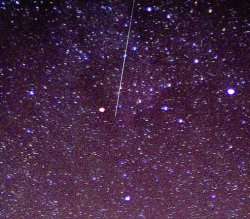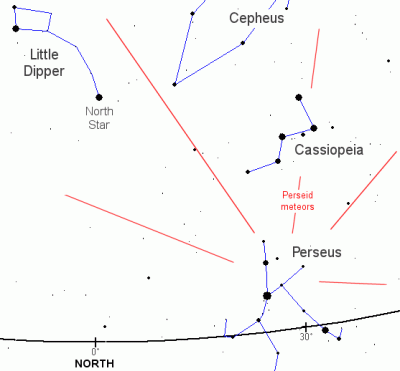A Perseid meteor photographed by Paul Evans on July 30, 2006--before the Moon got too bright.
Blame it on the Moon: The 2006 Perseid meteor shower is going to be a dud. Oh, Earth will pass through the Perseid meteoroid stream, as usual. And meteors will flit across the sky. But when the shower peaks on Saturday morning, August 12th, the glare of the 87%-full Moon will overwhelm most Perseids, making them impossible to see.
That sounds like the end of the story—but don't stop reading.
You might see some Perseids, after all. The trick is to look before the Moon rises. Plan your meteor watch for 8:30 p.m. to 10 p.m. on Friday, August 11. The Moon won't be up yet and, in the darkness just after sunset, a special kind of meteor may appear: the Perseid Earthgrazer.
Earthgrazers are meteors that skim the top of Earth's atmosphere like a stone skipping across the surface of a pond. They appear when the radiant of a meteor shower is near the horizon, spewing meteoroids not down, but horizontally overhead. Such will be the case on Friday evening after sunset when Perseus (the radiant of the Perseids) first peeks over the northern horizon.
Sky map, looking north after sunset, Friday evening, Aug. 11, 2006.
Don't expect a storm. Earthgrazers are rare. An hour's watching might net no more than one or two, but that's plenty. Earthgrazers are colorful and gracefully slow. People who see one talk about it for years.
Looking for Earthgrazers is simple: Spread a blanket on the ground, lie down and look up. A reclining lawn chair facing north works just as well. Perseid Earthgrazers streak overhead, flying generally north to south.
If you haven't spotted an Earthgrazer by 10 p.m., you probably won't. By 10 p.m., Perseus will have risen too high in the sky for grazing meteoroids. (Try skipping a stone by throwing it down into a pond and you'll see the problem.) Plus, the Moon itself rises around 10 p.m. to put a real damper on things.
The rest of the night is for contrarians, people who stay up until dawn in spite of the moonlight. They'll see some Perseids, a small fraction of the norm, to be sure, but not zero. Occasionally, a really bright fireball might streak across the sky, making the long night worthwhile. It pays to resist!
Next year will be better. The 2007 Perseids peak with no Moon in sight. Until then, watch out for Earthgrazers.
Note: All times in this story are local to the reader. So, "plan your meteor watch for 8:30 and 10 p.m." means go outside between 8:30 and 10:00 p.m. local time, no matter where you live. Perseid meteors are best seen from Earth's northern hemisphere.
Source: by Dr. Tony Phillips, Science@NASA

























